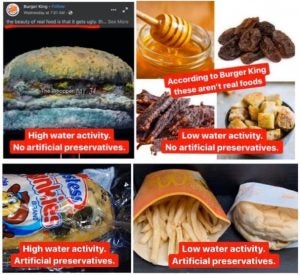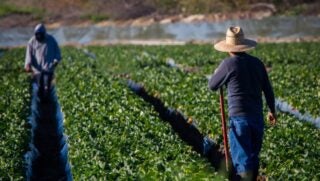“The beauty of real food is that it gets ugly.” This is the tagline for Burger King’s new fear-based marketing campaign. They are rolling out a Whopper free from artificial preservatives that will be available at all of their restaurants in the U.S. by the end of this year.
Why the big announcement? Because, marketing. Consumers tend to be unnecessarily afraid of anything labeled as “artificial” when it comes to food. Oh, and because they’re also playing off of everyone’s fear of the viral 10-year-old “immortal” McDonald’s burger that looks “perfectly fine,” therefore, it MUST not be real food!
So, what did Burger King do to showcase this new “real” whopper. They recently debuted a 45 second time lapse video of their new artificial-preservative-free Whopper over 34 days progressively growing more and more mold. Appetizing, I know. Checkmate Micky Dees. Our food molds, therefore, it’s real. Your food doesn’t, therefore, it’s fake. This is the reasoning they want consumers to follow, and it’s working. I fully expected to enter the comments section of their social media posts to witness the majority of people giving them crap about how blatantly ridiculous this new ad campaign was. Wow, was I wrong! There are thousands of comments praising them for being so “bold” and standing up to make food healthier and more sustainable by getting rid of big, bad, scary artificial preservatives. I’m sorry, WHAT? Does anybody understand science around here? I recognized some comments from a few of my followers laying down the law, so thank you. I wish there were more of you to help me stand up for science!
Just a few months ago, I wrote an article about that “immortal” McDonald’s meal and why it never got moldy. It’s actually a really simple explanation, and it has to do with a preservation method that has been used for thousands of years: dehydration, as well as something called water activity (aw). Moisture migrates from areas of high aw to areas of low aw until equilibrium is established. So, if the aw of the food is greater than that of the surrounding air, the moisture will migrate from the food to the air, thereby decreasing the aw of the food. If the equilibrium aw is lower than what is required for mold and bacterial growth and is reached before any microorganisms have had a chance to grow, then mold and bacteria simply won’t be present on the resulting dried out food.
Drying, or dehydration, has been used to preserve foods such as fruit, meat, and bread for thousands of years, yet for some reason people continue to get freaked out when it happens to a fast food meal, but have no issues with eating raisins, beef jerky, or croutons. That’s not to say that the 10-year-old fast food meal is OK to eat. It most certainly is not. There are other indicators of food spoilage, such as the oxidation of fats, which results in rancidity. So, just because there may not be visual indicators, such as mold, it certainly doesn’t mean that the food hasn’t gone bad. Also, this in no way means that the food is not “real.” If that were the case, then honey, raisins, beef jerky and other low water activity foods wouldn’t be considered to be “real” food either.

In fact, that same moldy whopper may not have molded at all if it were set out in a dry environment and dried out before the mold had a chance to grow, regardless of the addition of preservatives or not. That’s exactly what happened to the 10-year-old McDonald’s burger in the picture above. Burger King and its agency partners actually had Whoppers decomposing in several places for several months — Sweden, Miami, Spain — to make sure they were getting consistent results. Huh, I wonder how many of them didn’t mold.
They actually did an experiment over at Serious Eats to test this very thing. Here’s the conclusion they came to:
“In my experiments, I cooked homemade burgers of identical shape and size, which showed that this phenomenon is not unique to McDonald’s hamburgers. Any burger of the same size and same shape will desiccate and refuse to rot in the exact same way.
“Larger burgers from McDonald’s, like Quarter Pounders, will start to mold before they completely dry out. Similarly, if you store a McDonald’s burger in an environment where moisture is retained (such as in a zipper-lock bag), it will also mold, identically to a homemade hamburger.”
It’s amazing how many things are so much less scary when you understand science! While preservatives can help to inhibit mold growth, they will only help for so long. If the water activity is high enough, eventually mold will grow.
Getting rid of artificial preservatives is synonymous with “healthier” and “safer” to the average consumer. In reality, preservatives can help to keep food safer for longer, which not only prevents many foodborne illnesses, such as botulinum poisoning, but also helps to reduce food waste. So no, this latest smoke and mirrors trick isn’t actually making the food safer or more nutritious either. It could actually be making it less safe and/or create more food waste. Not to mention that the changes they are making are incredibly minor. A spokeswoman for the company said that sodium benzoate would be removed from the pickles and replaced with lactic acid; EDTA would be removed from the mayonnaise; and calcium propionate would be removed from the buns and replaced with cultured wheat flour. These are all safe ingredients despite negative consumer perceptions. They are replacing calcium propionate with bacteria that produce propionic acid, so it’s basically just a natural source of the same preservative. However, now they can claim “no artificial preservatives,” which sounds good to the consumer.
This latest BK ad campaign is nothing but a calculated, scientifically incorrect fearmongering over perfectly safe preservatives.
Fernando Machado, global chief marketing officer for Restaurant Brands International — Burger King’s parent company — told Forbes in an interview: “We thought, let’s show that the beauty of real food is that it actually gets ugly. Right? Let’s show that because we don’t have preservatives from artificial sources, our product does decay. And let’s show that in a beautiful way. I think that is what works well here. If Burger King had done a classic campaign of someone taking a bite of a normal-looking burger to explain the updated ingredients, Machado said it wouldn’t have received attention. (He said it would have taken a “mountain of money” to push that message through.)”
So, it seems that their global chief marketing officer doesn’t even understand the basic concept of water activity. Although the unappetizing ad may have gotten quite a bit of attention, it definitely wasn’t all positive attention. They got quite a few well deserved puke face emojis on their posts, and this hilarious comment showed up on one of my posts: “we were getting lunch the other day and my 5 year old freaked out when I suggested Burger King. She said, ‘Noo they have moldy food!’ Ha, well, perhaps it’s backfiring in many cases.”
I really couldn’t care less whether people buy more Whoppers or not. What matters is science and scientific literacy. This marketing campaign, while it may be “bold” and clever, does so at the expense of science and does nothing but further erode consumer trust of perfectly safe food ingredients. If we are going to do what’s best for the environment and human health, let’s begin by not only marketing health and sustainability, but by actually doing what’s best for human health and the environment.
Food Science Babe is the pseudonym of an agvocate and writer who focuses specifically on the science behind our food. She has a degree in chemical engineering and has worked in the food industry for more than decade, both in the conventional and in the natural/organic sectors.



